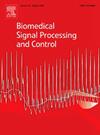MuRAt-CAP-Net: A novel multi-input residual attention network for automated detection of A-phases and subtypes in cyclic alternating patterns
IF 4.9
2区 医学
Q1 ENGINEERING, BIOMEDICAL
引用次数: 0
Abstract
Cyclic Alternating Pattern (CAP) is an essential biomarker for evaluating sleep microstructure, analyzing sleep stability and detecting various sleep disorders. The manual scoring of the CAP A-phase and its subtypes (A1, A2, A3) is a time-consuming, complex and expert-dependent. In this study, we propose a novel deep learning model named the multi-input residual attention CAP network (MuRAt-CAP-Net) for the automated detection of CAP A-phase and its subtypes. MuRAt-CAP-Net, with its multi-input architecture, simultaneously processes signals from four EEG channels (C4-P4, F4-C4, Fp2-F4, P4-O2) originating from different cortical areas. Additionally, the integrated attention mechanisms enable the model to focus on the most relevant features. The performance of MuRAt-CAP-Net was evaluated on both balanced and imbalanced datasets using a 5-fold cross-validation strategy. For A-phase classification, the model achieved an accuracy of 81.26 % and an F1-score of 81.13 % on the balanced dataset, while achieving 83.68 % accuracy and 88.38 % F1-score on the imbalanced dataset. For subtype classification, the model achieved an accuracy of 83.34 % and an F1-score of 83.38 % on the balanced dataset, and 87.31 % accuracy and 84.64 % F1-score on the imbalanced dataset. Compared to state-of-the-art methods, MuRAt-CAP-Net demonstrated superior performance in the detection of CAP A-phases and their subtypes. Furthermore, to enhance interpretability, Grad-CAM was applied to visualize the temporal and spectral focus of the MuRAt-CAP-Net’s decisions, revealing physiologically consistent patterns and supporting the clinical reliability of the model. Additionally, this study provides a comprehensive analysis of the impact of different EEG channel combinations, input window durations, and attention mechanisms on model performance.
MuRAt-CAP-Net:一种新的多输入剩余注意网络,用于循环交替模式中A相和亚型的自动检测
循环交替模式(CAP)是评价睡眠微观结构、分析睡眠稳定性和检测各种睡眠障碍的重要生物标志物。CAP a期及其亚型(A1、A2、A3)的人工评分耗时、复杂且依赖专家。在这项研究中,我们提出了一种新的深度学习模型,称为多输入剩余注意CAP网络(MuRAt-CAP-Net),用于CAP a阶段及其亚型的自动检测。MuRAt-CAP-Net采用多输入架构,同时处理来自不同皮层区域的4个EEG通道(C4-P4、F4-C4、Fp2-F4、P4-O2)的信号。此外,集成的注意力机制使模型能够关注最相关的特征。使用5倍交叉验证策略对平衡和不平衡数据集的MuRAt-CAP-Net的性能进行了评估。对于a阶段分类,该模型在平衡数据集上的准确率为81.26%,f1分数为81.13%,在不平衡数据集上的准确率为83.68%,f1分数为88.38%。对于子类型分类,该模型在平衡数据集上的准确率为83.34%,f1分数为83.38%;在不平衡数据集上的准确率为87.31%,f1分数为84.64%。与最先进的方法相比,MuRAt-CAP-Net在检测CAP a相及其亚型方面表现出优越的性能。此外,为了提高可解释性,我们应用Grad-CAM可视化MuRAt-CAP-Net决策的时间和光谱焦点,揭示生理上一致的模式,并支持模型的临床可靠性。此外,本研究还全面分析了不同脑电通道组合、输入窗口持续时间和注意机制对模型性能的影响。
本文章由计算机程序翻译,如有差异,请以英文原文为准。
求助全文
约1分钟内获得全文
求助全文
来源期刊

Biomedical Signal Processing and Control
工程技术-工程:生物医学
CiteScore
9.80
自引率
13.70%
发文量
822
审稿时长
4 months
期刊介绍:
Biomedical Signal Processing and Control aims to provide a cross-disciplinary international forum for the interchange of information on research in the measurement and analysis of signals and images in clinical medicine and the biological sciences. Emphasis is placed on contributions dealing with the practical, applications-led research on the use of methods and devices in clinical diagnosis, patient monitoring and management.
Biomedical Signal Processing and Control reflects the main areas in which these methods are being used and developed at the interface of both engineering and clinical science. The scope of the journal is defined to include relevant review papers, technical notes, short communications and letters. Tutorial papers and special issues will also be published.
 求助内容:
求助内容: 应助结果提醒方式:
应助结果提醒方式:


